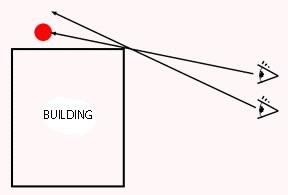Photographers often speak of the depth in a printed image although a two-dimensional image has, by definition, no physical depth. The illusion of depth can however be created by skilled photographers by manipulating perspective, tonal gradation, contrast and so on. The viewer knows by experience that a large object such as a building which appears smaller in an image than a person must be much further away. The brain interprets such information in extremely sophisticated ways without us even realizing what has happened.
True 3D imaging, sometimes known as stereoscopic imaging, relies upon a pair of slightly different images which simulate the inputs received by our two eyes. A person with normal vision perceives the world simultaneously through two different lenses (eyes) separated horizontally by a few inches. The images received by the two eyes are different principally because of the different locations relative to the subject from which they are captured. In the extreme example shown in the diagram it is easy to see why the red ball is perceived by one eye but not the other.

The two images captured by our eyes from different viewpoints are combined by the brain to create a three-dimensional image which gives human beings their spatial sense. People with normal sight are consequently well able to perceive a true three-dimensional world. Those with eye defects, or who use only one eye, may have more difficulty with spatial perception but nevertheless develop effective means of coping with the world through experience, the perception of perspective and so on. These techniques are much the same as those used by normally-sighted people when viewing a two-dimensional photograph.
The two images required to produce a 3D or stereo image can be produced in a number of ways. The simplest approach, although not the best, is to use a normal camera to capture two similar images of the subject from slightly different viewpoints. The subject must remain motionless because the two images are by necessity taken at different times. Another basic approach uses two adjacent camera whose shutters are released simultaneously.
A more practical approach to 3D or stereo photography uses a custom-made stereo camera fitted with two lenses. This is designed to duplicate the views perceived by human beings, with the two lenses separated by a distance comparable with the separation of a pair of eyes. When the two images are then presented to two eyes, only one image being visible to each eye, the brain combines them in to a single spatial image which provides a real impression of depth.






